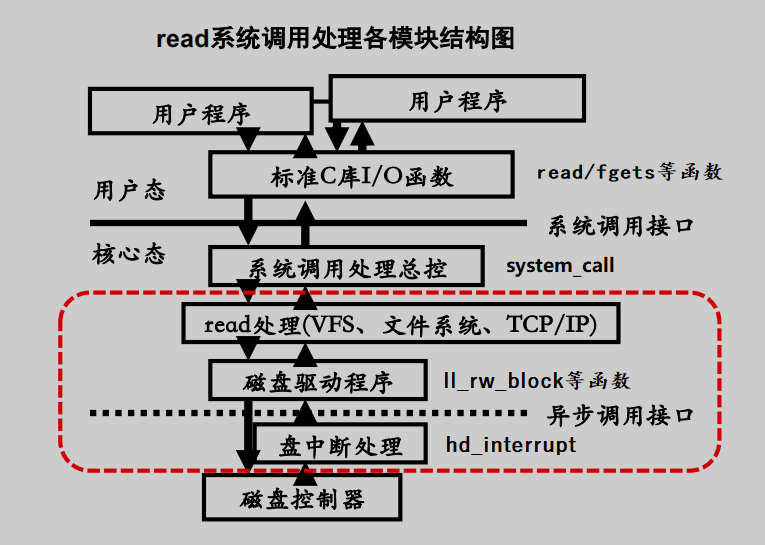用户进程read、write在高速缓冲块上读写数据,高速缓冲块和块设备交换数据。
- 什么时机将磁盘块数据读到缓冲块?
- 什么时机将缓冲块数据刷到磁盘块?

- read/write(c库函数,通过int 80调用sys_read/sys_write)
- sys_read/sys_write
- block_read/block_write
- breada
- getblk
- sync_dev
- ll_rw_block
- getblk
- breada
- block_read/block_write
- sys_read/sys_write
代码文件:linux-0.11/fs/read_write.c
系统调用sys_read与sys_write是内核提供给用户程序调用的IO接口。若IO设备是块设备,底层分别调用block_read与block_write进行块设备的读写。
sys_readint sys_read(unsigned int fd,char * buf,int count)
{
struct file * file;
struct m_inode * inode;
// 通过文件描述符,在file表中找到file结构地址
if (fd>=NR_OPEN || count<0 || !(file=current->filp[fd]))
return -EINVAL;
if (!count)
return 0;
verify_area(buf,count);
inode = file->f_inode; // 通过file的f_inode访问inode节点
//判断是什么设备:管道、字符设备、块设备
//如果是块设备,调用block_read读块设备
if (inode->i_pipe)
return (file->f_mode&1)?read_pipe(inode,buf,count):-EIO;
if (S_ISCHR(inode->i_mode))
return rw_char(READ,inode->i_zone[0],buf,count,&file->f_pos);
if (S_ISBLK(inode->i_mode))
return block_read(inode->i_zone[0],&file->f_pos,buf,count);
if (S_ISDIR(inode->i_mode) || S_ISREG(inode->i_mode)) {
if (count+file->f_pos > inode->i_size)
count = inode->i_size - file->f_pos;
if (count<=0)
return 0;
return file_read(inode,file,buf,count);
}
printk("(Read)inode->i_mode=%06o\n\r",inode->i_mode);
return -EINVAL;
}
int sys_write(unsigned int fd,char * buf,int count)
{
struct file * file;
struct m_inode * inode;
if (fd>=NR_OPEN || count <0 || !(file=current->filp[fd]))
return -EINVAL;
if (!count)
return 0;
//判断是什么设备:管道、字符设备、块设备
//如果是块设备,调用block_write读块设备
inode=file->f_inode;
if (inode->i_pipe)
return (file->f_mode&2)?write_pipe(inode,buf,count):-EIO;
if (S_ISCHR(inode->i_mode))
return rw_char(WRITE,inode->i_zone[0],buf,count,&file->f_pos);
if (S_ISBLK(inode->i_mode))
return block_write(inode->i_zone[0],&file->f_pos,buf,count);
if (S_ISREG(inode->i_mode))
return file_write(inode,file,buf,count);
printk("(Write)inode->i_mode=%06o\n\r",inode->i_mode);
return -EINVAL;
}
block_read与block_write负责块设备的读写。他们底层调用breada函数获取缓冲块,然后在缓冲块上读写数据。
block_write代码文件:linux-0.11/fs/block_dev.c
int block_write(int dev, long * pos, char * buf, int count)
{
int block = *pos >> BLOCK_SIZE_BITS;// pos所在文件数据块号
int offset = *pos & (BLOCK_SIZE-1); // pos在数据块中偏移值
int chars;
int written = 0;
struct buffer_head * bh; //指向当前写缓冲块
register char * p;
// 向缓冲块中写数据,通过getblk获取缓冲块,获取缓冲块的同时会读取磁盘块数据到缓冲块
// 数据量较多时,通过bread一次性缓存3个磁盘块数据到缓冲块,减小磁盘IO次数
while (count>0) {
chars = BLOCK_SIZE - offset;
if (chars > count)
chars=count;
if (chars == BLOCK_SIZE)
//获取高速缓冲块,并建立其与磁盘块的映射关系
bh = getblk(dev,block);
else
// 读取的数据超过一个磁盘块,调用breada读多个块
// breada底层调用getblk缓存3个连续磁盘块的数据
bh = breada(dev,block,block+1,block+2,-1);
block++;
if (!bh)
return written?written:-EIO;
p = offset + bh->b_data;
offset = 0;
*pos += chars;
written += chars;
count -= chars;
while (chars-->0)
*(p++) = get_fs_byte(buf++);
//完成对缓冲块的数据写入后,设置缓冲块的修改位dirt,然后释放缓冲块(引用计数减一)
bh->b_dirt = 1;
brelse(bh);
}
return written;
}
代码文件:linux-0.11/fs/block_dev.c
int block_read(int dev, unsigned long * pos, char * buf, int count)
{
int block = *pos >> BLOCK_SIZE_BITS;
int offset = *pos & (BLOCK_SIZE-1);
int chars;
int read = 0;
struct buffer_head * bh;
register char * p;
while (count>0) {
chars = BLOCK_SIZE-offset;
if (chars > count)
chars = count;
if (!(bh = breada(dev,block,block+1,block+2,-1)))
return read?read:-EIO;
block++;
p = offset + bh->b_data;
offset = 0;
*pos += chars;
read += chars;
count -= chars;
while (chars-->0)
put_fs_byte(*(p++),buf++);
//完成对缓冲块的数据读取之后,释放缓冲块(引用计数减一)
brelse(bh);
}
return read;
}
代码文件:linux-0.11/fs/buffer.c
- bread:块读取函数
- breada:块提前预读函数
- bread_page:页块读取函数,一个内存页通常为4k大小、磁盘块通常为1k大小
bread、breada、bread_page三者功能相似,用法不同。三者均会调用getblk获取缓冲块,并调用ll_rw_block读数据到缓冲块。
struct buffer_head * bread(int dev,int block)
{
struct buffer_head * bh;
if (!(bh=getblk(dev,block)))
panic("bread: getblk returned NULL\n");
if (bh->b_uptodate)
return bh;
// 调用ll_rw_block读磁盘块数据到缓冲区
ll_rw_block(READ,bh);
wait_on_buffer(bh);
if (bh->b_uptodate)
return bh;
brelse(bh);
return NULL;
}
代码文件:linux-0.11/fs/buffer.c
bread系列函数通过getblk获取缓冲块,在必要的时候,会调用sync_dev函数将脏缓冲块数据写入磁盘。
getblk代码逻辑复杂,需要对资源可用性进行复杂的检查。资源不可用时,需要睡眠,被唤醒之后又要进行一些检查判断资源是否可用。复杂逻辑可以暂时不考虑,避免陷入代码细节。
仅考虑getblk获取空闲块之后的代码逻辑。getblk获取可用缓冲块后,若缓冲块dirt位为1,表示缓冲块有数据未同步到磁盘,getblk将调用sync_dev将数据同步到磁盘,然后占用该缓冲块。
struct buffer_head * getblk(int dev,int block)
{
struct buffer_head * tmp, * bh;
repeat:
// 搜索hash表,如果指定块已经在高速缓冲中,则返回对应缓冲区头指针,退出。
if ((bh = get_hash_table(dev,block)))
return bh;
// 扫描空闲数据块链表,寻找空闲缓冲区。
tmp = free_list;
do {
// 如果该缓冲区正被使用(引用计数不等于0)
if (tmp->b_count)
continue;
// 找到可用缓冲块,且满足一些条件
if (!bh || BADNESS(tmp)<BADNESS(bh)) {
bh = tmp;
if (!BADNESS(tmp))
break;
}
/* and repeat until we find something good */
} while ((tmp = tmp->b_next_free) != free_list);
// 没有可用缓冲块,则睡眠等待有空闲缓冲块可用。
// 当有空闲缓冲块可用时本进程会被的唤醒。
if (!bh) {
sleep_on(&buffer_wait); //睡眠在缓冲区上
goto repeat;
}
//等待缓冲区解锁?
wait_on_buffer(bh);
if (bh->b_count)
goto repeat;
// 分配到的缓冲块dirt位为1(表示有数据未同步到磁盘)
// 调用sync_dev将数据同步到磁盘,并睡眠在该缓冲块上
while (bh->b_dirt) {
sync_dev(bh->b_dev);
wait_on_buffer(bh);
if (bh->b_count)
goto repeat;
}
/* NOTE!! While we slept waiting for this block, somebody else might */
/* already have added "this" block to the cache. check it */
if (find_buffer(dev,block))
goto repeat;
/* OK, FINALLY we know that this buffer is the only one of it's kind, */
/* and that it's unused (b_count=0), unlocked (b_lock=0), and clean */
// 对空闲缓冲块的处理
// 占用空闲缓冲块。置引用计数为1,复位修改标志和有效(更新)标志。
bh->b_count=1;
bh->b_dirt=0;
bh->b_uptodate=0;
// 从原hash队列和空闲队列块链表中移出该缓冲区头。根据此新的设备号和块号重新插入空闲链表和hash队列
// 让该缓冲区用于指定设备和其上的指定块。
// 根据此新的设备号和块号重新哈希,并插入响应的hash队列
remove_from_queues(bh);
bh->b_dev=dev;
bh->b_blocknr=block; //加锁
insert_into_queues(bh);
return bh;
}
代码文件:linux-0.11/fs/buffer.c
调用ll_rw_block将缓冲块内数据写入磁盘。getblk管理缓冲块时,若其它进程需要某缓冲块,且缓冲块具有脏(dirt位为1)数据,调用sync_dev将数据写入磁盘。
int sync_dev(int dev)
{
int i;
struct buffer_head * bh;
bh = start_buffer;
for (i=0 ; i<NR_BUFFERS ; i++,bh++) {
if (bh->b_dev != dev)
continue;
wait_on_buffer(bh);
if (bh->b_dev == dev && bh->b_dirt)
// 调用ll_rw_block写缓冲区数据到磁盘块
ll_rw_block(WRITE,bh);
}
bh = start_buffer;
for (i=0 ; i<NR_BUFFERS ; i++,bh++) {
if (bh->b_dev != dev)
continue;
wait_on_buffer(bh);
if (bh->b_dev == dev && bh->b_dirt)
ll_rw_block(WRITE,bh);
}
return 0;
}
代码文件:linux-0.11/kernel/blk_drv/ll_rw_blk.c
将缓冲块的数据写入磁盘块,获将磁盘块数据读入缓冲块,底层通过设备请求队列完成读写。
void ll_rw_block(int rw, struct buffer_head * bh)
{
unsigned int major;
if ((major=MAJOR(bh->b_dev)) >= NR_BLK_DEV ||
!(blk_dev[major].request_fn)) {
printk("Trying to read nonexistent block-device\n\r");
return;
}
// 将读写请求加入设备请求队列
make_request(major,rw,bh);
}
代码文件:linux-0.11/kernel/blk_drv/hd.c
- 读完成中断处理程序
设备完成读扇区数据后,发出读中断,读中断处理程序read_intr执行。若当前读请求还有数据要读,则继续完成当前请求的数据读。因为,一次读请求可能读若干连续扇区数据,磁盘每次只能写读一个扇区数据。完成一次读请求的所有数据读之后,将调用do_hd_request处理下一个写请求。
static void read_intr(void)
{
if (win_result()) {
bad_rw_intr();
do_hd_request();
return;
}
port_read(HD_DATA,CURRENT->buffer,256);
CURRENT->errors = 0;
CURRENT->buffer += 512;
CURRENT->sector++;
if (--CURRENT->nr_sectors) {
do_hd = &read_intr;
return;
}
end_request(1);
do_hd_request();
}
- 写完成中断处理程序
与写完成中断处理程序过程类似。
static void write_intr(void)
{
if (win_result()) {
bad_rw_intr();
do_hd_request(); //处理下一个请求
return;
}
if (--CURRENT->nr_sectors) {
CURRENT->sector++;
CURRENT->buffer += 512;
do_hd = &write_intr;
port_write(HD_DATA,CURRENT->buffer,256);
return;
}
end_request(1);
do_hd_request();
}
- 处理读写队列请求
处理设备请求队列的读写请求。设备中断处理程序不断调用do_hd_request处理请求队列,直到请求队列为空。
void do_hd_request(void)
{
int i,r = 0;
unsigned int block,dev;
unsigned int sec,head,cyl;
unsigned int nsect;
INIT_REQUEST;
dev = MINOR(CURRENT->dev);
block = CURRENT->sector;
if (dev >= 5*NR_HD || block+2 > hd[dev].nr_sects) {
end_request(0);
goto repeat;
}
block += hd[dev].start_sect;
dev /= 5;
__asm__("divl %4":"=a" (block),"=d" (sec):"0" (block),"1" (0),
"r" (hd_info[dev].sect));
__asm__("divl %4":"=a" (cyl),"=d" (head):"0" (block),"1" (0),
"r" (hd_info[dev].head));
sec++;
nsect = CURRENT->nr_sectors;
if (reset) {
reset = 0;
recalibrate = 1;
reset_hd(CURRENT_DEV);
return;
}
if (recalibrate) {
recalibrate = 0;
hd_out(dev,hd_info[CURRENT_DEV].sect,0,0,0,
WIN_RESTORE,&recal_intr);
return;
}
if (CURRENT->cmd == WRITE) {
hd_out(dev,nsect,sec,head,cyl,WIN_WRITE,&write_intr);
for(i=0 ; i<3000 && !(r=inb_p(HD_STATUS)&DRQ_STAT) ; i++)
/* nothing */ ;
if (!r) {
bad_rw_intr();
goto repeat;
}
port_write(HD_DATA,CURRENT->buffer,256);
} else if (CURRENT->cmd == READ) {
hd_out(dev,nsect,sec,head,cyl,WIN_READ,&read_intr);
} else
panic("unknown hd-command");
}
